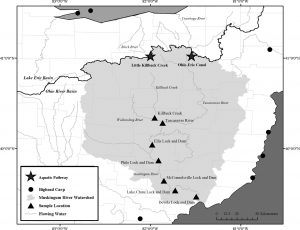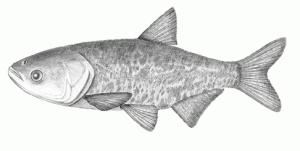Active and passive environmental DNA surveillance of aquatic invasive species
By Jake Jerome, SRC graduate student
Species that are not typically found in a certain environment or geographical location are known as invasive species. Invasive species can be harmful to the natural ecosystem and the organisms that typically reside there. Monitoring the introduction or spread of invasive species is important to environmental managers so they can control their populations and attempt to retain balance in an ecosystem. One way that researchers can monitor invasive species is through the surveillance of environmental DNA (eDNA).
In the Muskingum River Watershed (MRW) in Ohio, Simmons et al 2015 looked for signs of the invasive Asian bighead carp (Hypophthalmichthys nobilis) and silver carp (Hypophthalmichthys molitrix) through both active and passive eDNA surveillance. Active eDNA surveillance is used to detect specific species within a sample. Passive surveillance, however, looks for all species present in a sample, potentially leading to species that were not known in that location. Because the MRW has intermittent water passages that lead to Lake Erie, it is important to survey the area to see if these two highly invasive carp species are present.
In October 2013, 211 water samples were collected from 7 sites found within the MRW. They were analyzed for eDNA both actively and passively to determine species that were present. The active surveillance of the two Asian carp species found eDNA of bighead carp in 10 samples from four locations while no detections were found of the silver carp. Besides showing the naturally occurring species, the passive surveillance of the water samples did not find eDNA from either of the Asian carp species. It did, however, detect the eDNA from a different invasive, the snakehead.

Environmental DNA water sample locations within the Muskingum River Watershed in eastern Ohio and surrounding bighead carp capture locations (bighead carp coordinates provided by Midwest Invasive Species Information Network, March 2015). (Simmons et al 2015)
The authors note that the discrepancy between the two methods for detecting the bighead carp are likely due to the sensitivity of active surveillance and the more broad approach used for passive surveillance. Despite this, it is clear that both techniques prove useful for managing aquatic invasive species. Used alone, active surveillance is useful for immediate, known threats but may miss unknown species or invaders that are not targeted. Together, active and passive surveillance of aquatic invasive species can give managers a holistic view of the area they are studying and hopefully further their conservation efforts in response.
Reference
Simmons, M., Tucker, A., Chadderton, L.W., Jerde, C.L., Mahon, A.R. (2015). Active and passive environmental DNA surveillance of aquatic invasive species. Can. J. Fish. Aquat. Sci. 73: 1-8.

